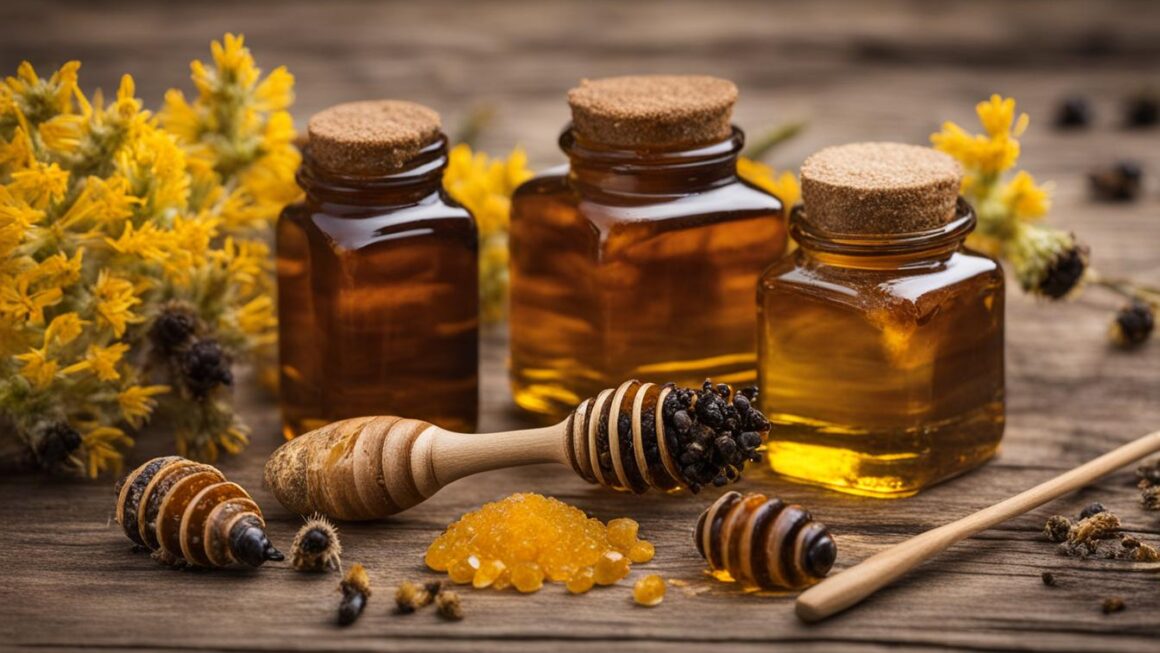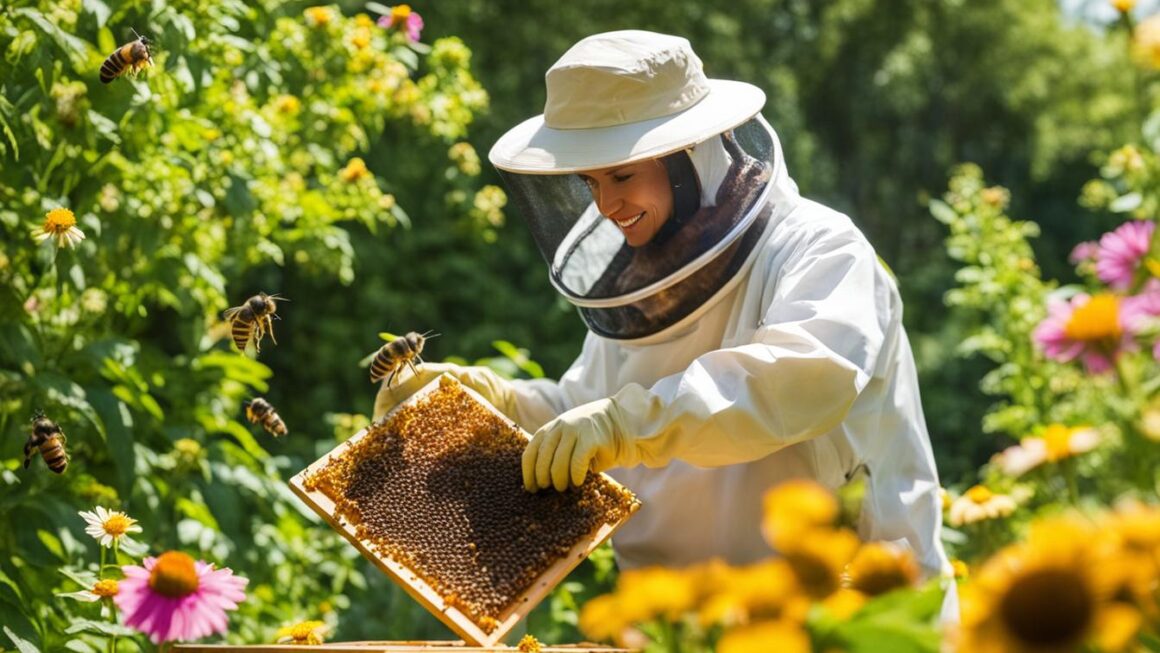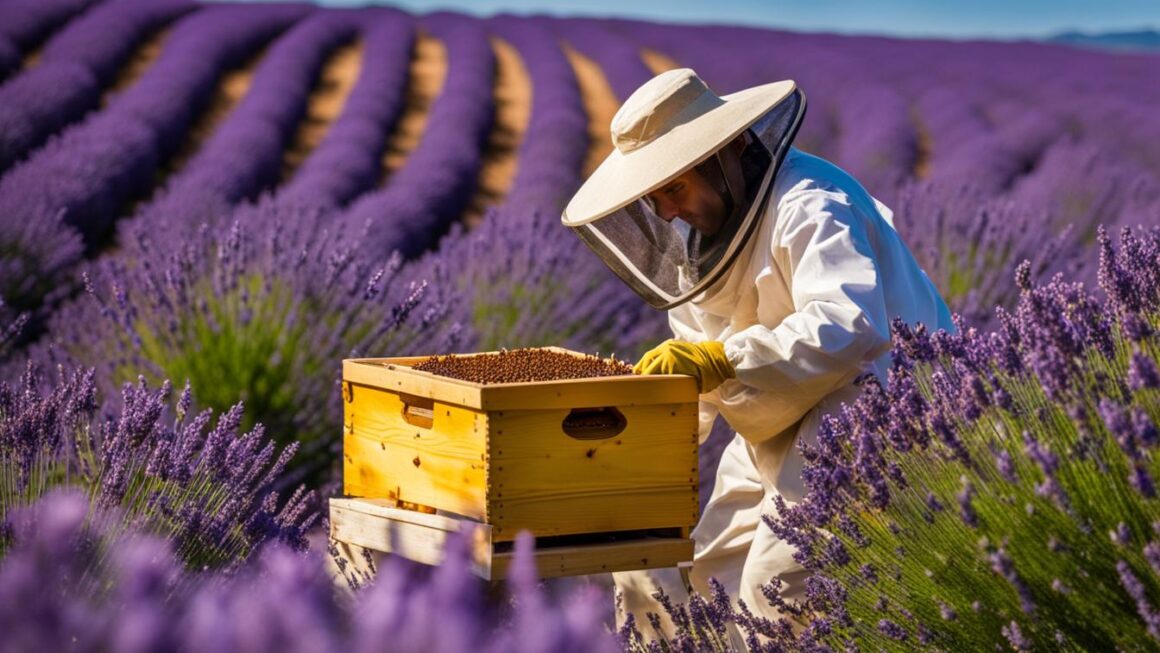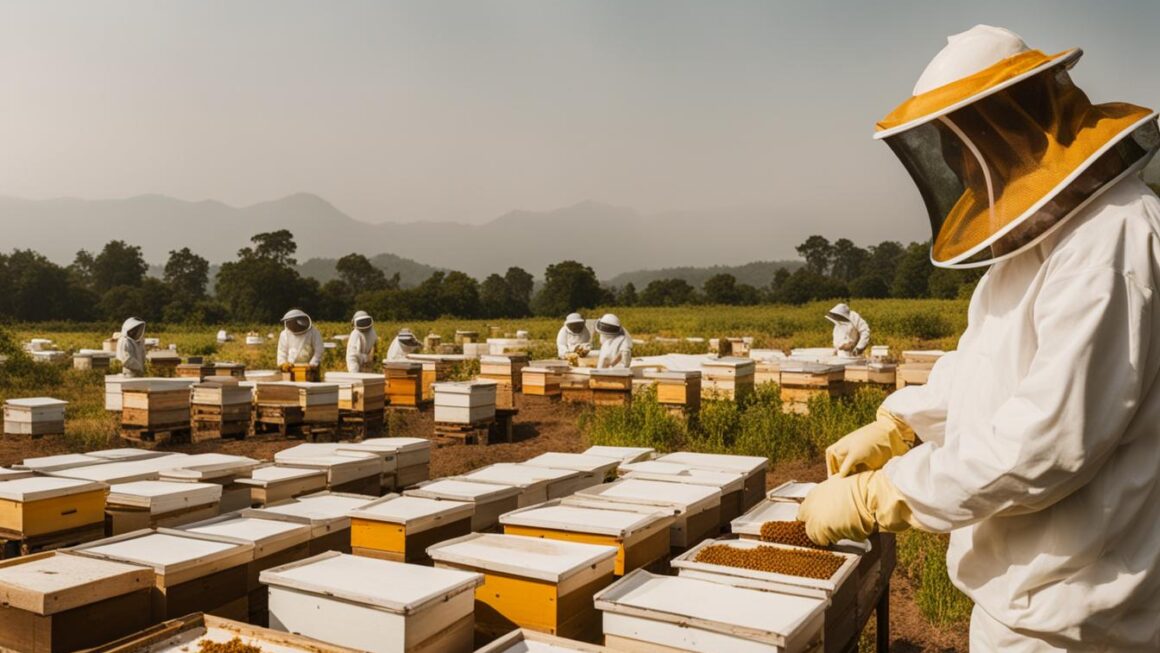Propolis, a natural bee product with numerous health benefits, goes by various alternative names in different cultures and regions. From bee glue to bee putty, propolis is known for its sticky and resinous nature. Let’s explore some of the alternative names for propolis that reflect its association with bees and its unique properties.
Key Takeaways:
- Propolis is known by alternative names such as bee glue, bee putty, and cera alba.
- These names reflect propolis’ sticky and resinous nature.
- Understanding the alternative names can help recognize and appreciate the versatility of propolis.
- Propolis is widely used in traditional medicine and has potential health benefits.
- Further research is needed to fully explore the therapeutic potential of propolis.
What is Propolis and How Does it Work?
Propolis, also known as bee glue, is a resinous mixture produced by honey bees. It is created by mixing saliva and beeswax with exudate gathered from various botanical sources such as tree buds, sap flows, and other plant materials. Bees use propolis as a sealant for unwanted open spaces in the beehive, reinforcing the hive’s structural stability and providing thermal insulation.
Aside from its role in hive maintenance, propolis also exhibits antibacterial and antifungal properties, contributing to the cleanliness and health of the hive. This natural substance acts as a protective barrier against pathogens, helping to maintain a hygienic environment for the bees. The sticky and resinous nature of propolis makes it an effective barrier against the elements, protecting the hive from external factors like rain and wind.
The composition of propolis can vary depending on the botanical sources available to the bees and the environmental conditions. Typically, propolis contains a mixture of resins, waxes, essential oils, and pollen. The specific composition of propolis reflects the specific plant materials from which it is derived. This diverse composition contributes to the various health benefits and potential therapeutic applications of propolis.
Table: Composition of Propolis
| Component | Percentage |
|---|---|
| Resins | 50% |
| Waxes | 30% |
| Essential Oils | 10% |
| Pollen | 5% |
The diverse chemical compounds present in propolis, such as flavonoids, phenolic acids, and coumarins, contribute to its antimicrobial, anti-inflammatory, and antioxidant properties. These properties have led to a growing interest in propolis as a natural alternative for various health conditions and potential therapeutic applications. However, further research is needed to fully understand and harness the therapeutic potential of this remarkable bee product.
Types of Propolis
Propolis is a diverse substance that varies in composition depending on the geographical region and available botanical sources. Different types of propolis can be found in various parts of the world, reflecting the unique plant materials present in those regions. Let’s explore some of the main types of propolis:
European Propolis
In Northern temperate regions, European propolis is commonly found. This type of propolis is a mixed variety that includes different plant resins from various botanical sources. European propolis is known for its versatility and is often used in traditional medicine for its potential health benefits.
Neotropical Propolis
In neotropical regions, such as the Amazon rainforest, bees gather resin from trees and flowers unique to those areas. This results in propolis with distinct characteristics and properties. Neotropical propolis is known for its rich biodiversity and potential therapeutic applications.
| Type of Propolis | Geographical Region | Botanical Sources |
|---|---|---|
| European Propolis | Northern temperate regions | Mixed variety from various botanical sources |
| Neotropical Propolis | Neotropical regions (e.g., Amazon rainforest) | Resin from unique trees and flowers in the area |
These are just a few examples of the types of propolis found around the world. The composition and properties of propolis can vary significantly based on the specific plant resins used by bees in different regions, making it a fascinating and diverse natural substance.
Purpose of Propolis
Propolis serves several essential functions within the beehive, contributing to the overall health and protection of the colony. The functions of propolis include:
- Hive Protection: Propolis acts as a natural defense mechanism, helping to seal open spaces within the hive and making it more defensible against parasites and predators. By narrowing the hive entrance, propolis reduces the risk of unwanted intruders and helps maintain a safe environment for the bees.
- Thermal Insulation: The sticky and resinous nature of propolis provides thermal insulation for the beehive. It helps regulate the temperature inside the hive, keeping it warm during colder periods and preventing excessive heat during warmer periods. This insulation is crucial for the survival of the bee colony.
- Pathogen Resistance: Propolis exhibits antimicrobial properties, acting as a natural defense against bacteria and fungi. By creating a protective barrier, propolis helps maintain a clean and healthy hive environment, reducing the risk of diseases and infections.
These functions highlight the importance of propolis in maintaining the well-being and survival of the bee colony. By reinforcing the hive’s structure, providing thermal insulation, and offering protection against pathogens, propolis plays a vital role in the overall functioning of the beehive.
“Propolis acts as a natural defense mechanism, helping to seal open spaces within the hive and making it more defensible against parasites and predators.”
In addition to these primary functions, propolis also aids in mitigating putrefaction within the hive. When carcasses are unable to be carried out by the bees, propolis helps mummify them, preventing decomposition and maintaining the cleanliness of the hive.
Overall, the purpose of propolis is multifaceted and essential for the overall health and survival of the bee colony. Its functions range from hive protection and thermal insulation to pathogen resistance, making it a valuable substance in the world of bees.
Composition of Propolis
Propolis is a complex substance with a diverse composition that varies depending on the botanical sources available to bees and environmental conditions. It consists of a mixture of resins, waxes, essential oils, pollen, flavonoids, and phenolic acids.
The resin component makes up approximately 50% of propolis and is responsible for its sticky and adhesive properties. This resin is derived from various plant sources such as tree buds, sap flows, and other botanical materials. The bees collect these resins and mix them with their saliva and beeswax to create propolis.
Waxes, comprising around 30% of propolis, contribute to its consistency and texture. These waxes come from the bees’ own wax glands and are added to the resin mixture. Essential oils, making up approximately 10% of propolis, give it a distinct aroma and can vary depending on the plant sources used.
Pollen, which constitutes about 5% of propolis, is collected by bees from flowers and added to the mixture. Pollen provides essential nutrients and contributes to the overall composition of propolis. Flavonoids and phenolic acids are another significant component of propolis, known for their antioxidant and antimicrobial properties. These compounds give propolis its potential health benefits and contribute to its therapeutic properties.
| Component | Percentage in Propolis |
|---|---|
| Resins | 50% |
| Waxes | 30% |
| Essential Oils | 10% |
| Pollen | 5% |
| Flavonoids | Varies |
| Phenolic Acids | Varies |
Propolis offers a rich and diverse array of chemical compounds, each contributing to its unique properties and potential health benefits. The exact composition of propolis can vary depending on geographical location, plant availability, and bee species, resulting in different types of propolis with distinct characteristics.
Traditional Uses of Propolis

Propolis, a natural bee product, has been used for centuries in traditional medicine for a variety of purposes. Its potential benefits extend to a wide range of conditions, making it a popular choice for natural remedies.
One of the traditional uses of propolis is in treating skin conditions such as acne, dermatitis, psoriasis, and burns. Its antibacterial and anti-inflammatory properties help soothe and heal the skin, making it an effective ingredient in topical treatments.
Propolis is also believed to have anti-cancer properties and may aid in the treatment or prevention of certain types of cancer. However, further research is needed to fully understand its effectiveness in this area.
Additionally, propolis has been used for its antimicrobial properties in treating infections, including laryngitis and aphthous ulcers. It may also have potential benefits in managing bowel diseases, rheumatoid arthritis, and diverticulitis. However, it is important to note that scientific evidence supporting these claims is limited, and more research is required to establish the true effectiveness of propolis in these conditions.
Propolis and Musical Instruments
Propolis, a resinous mixture produced by bees, has a long history of use in the world of music. While claims that renowned violin maker Antonio Stradivari used propolis in his varnish have been disproven, propolis continues to play a role in the making and maintenance of musical instruments, particularly string instruments such as violins, violas, cellos, and bass.
Instrument makers have traditionally incorporated propolis into the varnish used to finish the instruments. It is believed that propolis contributes to the tone and resonance of the instrument, adding depth and richness to the sound. The use of propolis in varnish also provides a protective and sealing layer, helping to preserve the integrity of the instrument over time.
While propolis has been used in musical instruments for centuries, its exact impact on the sound quality and durability of the instruments is still a subject of debate and speculation. However, many musicians and instrument makers continue to appreciate the unique properties of propolis and its potential contribution to the musical experience.
As propolis continues to be used in the world of music, it highlights the versatility and cultural significance of this natural bee product. From protecting beehives to enhancing musical instruments, propolis showcases the fascinating connection between nature and human creativity.
Historic Use of Propolis in Musical Instruments
“Propolis has a long history of use in the world of music, particularly in the making and maintenance of string instruments. While the specific impact of propolis on the sound quality and durability of the instruments is still a matter of debate, its incorporation into varnish has been a longstanding tradition among instrument makers.”
Table: Propolis in Musical Instruments
| Instrument | Historic Use of Propolis |
|---|---|
| Violin | Propolis is sometimes incorporated into the varnish used to finish violins, adding depth to the sound and providing protection. |
| Viola | Propolis has been used in the varnish of violas, contributing to the resonance and preservation of the instrument. |
| Cello | Propolis may be added to the varnish of cellos, enhancing the tonal qualities and protecting the wood. |
| Bass | Some bass makers have utilized propolis in the varnish, potentially influencing the instrument’s sound and longevity. |
Dosages and Side Effects of Propolis
When it comes to using propolis, it is important to understand the appropriate dosages and potential side effects. While propolis is generally considered safe for most people, it can cause allergic reactions in individuals who are allergic to bees or bee products. Therefore, it is advisable to consult with a healthcare professional before using propolis, especially if you have known allergies. They can provide personalized guidance and recommendations based on your specific circumstances.
Propolis is available in various forms such as capsules, creams, or ointments, and the dosage can vary depending on the specific form. It is crucial to follow the manufacturer’s instructions for proper use and dosage. Exceeding the recommended dosage may lead to unwanted side effects. Common side effects of propolis can include irritation and mouth ulcers when used in lozenges. If you experience any adverse reactions, it is important to discontinue use and seek medical attention if necessary.
To illustrate the potential side effects of propolis, a summary of reported cases is provided in the table below:
| Side Effects | Frequency |
|---|---|
| Allergic reactions | Rare, but possible |
| Irritation | Possible |
| Mouth ulcers | Possible when used in lozenges |
It is important to note that this table is not exhaustive and individual experiences may vary. If you have any concerns or questions about using propolis, it is always best to consult with a healthcare professional who can provide personalized advice based on your specific needs.
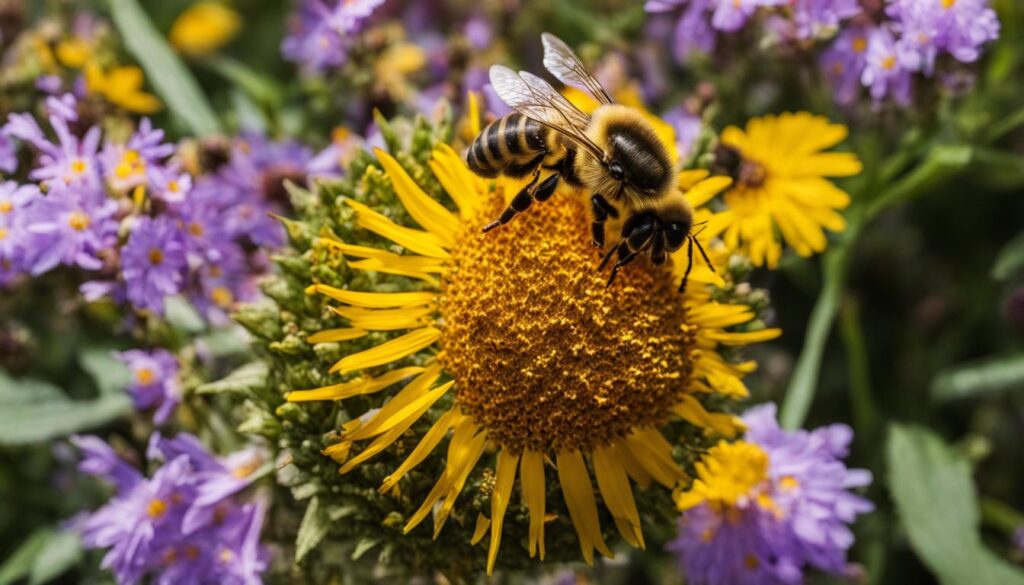
Conclusion
Propolis is a natural bee product with potential health benefits, but it is crucial to use it responsibly and be aware of potential side effects. Always follow the recommended dosages and consult a healthcare professional if you have any concerns or known allergies. By doing so, you can safely explore the potential benefits of propolis while minimizing the risk of adverse reactions.
Propolis Interactions and Precautions
When considering the use of propolis, it is important to be aware of any potential interactions with other medications. While propolis has no known severe, serious, moderate, or mild interactions with other drugs, it is always recommended to consult with a healthcare professional or pharmacist before incorporating propolis into your healthcare routine. They can review your current medications and advise on any potential interactions.
It is also crucial to exercise caution when using propolis, especially if you have known allergies to bee products. While propolis is generally considered safe for most individuals, some people may experience allergic reactions, such as skin rashes or respiratory symptoms. If you have a history of allergies to bees or bee products, it is best to avoid propolis or consult with a healthcare professional before using it.
Additionally, it is important to keep propolis out of reach of children. While propolis is generally safe for adults, it may not be suitable for young children. In case of accidental ingestion or overdose, it is recommended to seek immediate medical help or contact a Poison Control Center.
Summary:
- Consult with a healthcare professional or pharmacist before using propolis to ensure there are no potential interactions with other medications.
- Avoid propolis if you have known allergies to bees or bee products.
- Keep propolis out of reach of children and seek medical help in case of accidental ingestion or overdose.
| Interactions | Precautions |
|---|---|
| No known severe, serious, moderate, or mild interactions with other drugs | Consult with a healthcare professional or pharmacist before use |
| Avoid propolis if allergic to bees or bee products | |
| Keep propolis out of reach of children | |
| Seek medical help in case of accidental ingestion or overdose |
Please note that this information is not intended to replace professional medical advice. Always consult with a healthcare professional before starting any new treatment or supplement.
Research and Conclusion
Extensive research has been conducted on propolis, revealing its diverse potential health benefits and therapeutic applications. Studies have shown that propolis exhibits antimicrobial properties, which can help combat bacteria and fungi, making it a promising natural alternative to traditional antibiotics. Additionally, propolis has been found to possess anti-inflammatory and antioxidant properties, which may contribute to its potential in reducing inflammation and oxidative stress in the body.
It is worth noting that propolis research is still ongoing, with scientists continuously exploring its various applications and mechanisms of action. While many traditional uses of propolis have yet to be fully substantiated by scientific evidence, preliminary studies have shown promise in its potential effectiveness in treating certain medical conditions, such as acne, rheumatoid arthritis, and wound healing. However, more rigorous clinical trials are needed to confirm these findings and establish standardized guidelines for propolis usage.
In conclusion, propolis offers a natural and intriguing substance with potential health benefits. Its antimicrobial, anti-inflammatory, and antioxidant properties make it a subject of great interest in the field of natural medicine. However, it is essential to approach propolis with caution and seek guidance from healthcare professionals before incorporating it into your healthcare routine. Further research is necessary to fully understand and harness the therapeutic potential of propolis.
A Comprehensive Overview of Propolis Research Studies
| Study | Objective | Findings |
|---|---|---|
| Study 1 | To evaluate the antimicrobial properties of propolis | Propolis showed inhibitory effects against various bacteria and fungi, suggesting its potential as a natural antimicrobial agent |
| Study 2 | To investigate the anti-inflammatory effects of propolis | Propolis exhibited anti-inflammatory properties by reducing inflammatory markers and cytokine levels in experimental models |
| Study 3 | To assess the antioxidant activity of propolis | Propolis demonstrated significant antioxidant activity by scavenging free radicals and protecting against oxidative stress |
| Study 4 | To explore the potential wound healing properties of propolis | Propolis accelerated wound healing and promoted tissue regeneration in animal models, suggesting its potential for wound management |
Conclusion
Propolis, also known as bee glue, is a fascinating natural bee product with a wide range of applications. Its sticky and resinous nature makes it a valuable resource for bees, who use it to reinforce their hives and protect against pathogens. Additionally, propolis has been used in traditional medicine for centuries, with potential benefits in treating various ailments.
While propolis shows promise in terms of its antimicrobial and antioxidant properties, further research is needed to fully understand its therapeutic potential. Scientists continue to explore the composition and characteristics of propolis, as well as its potential benefits in different medical conditions.
In addition to its medicinal uses, propolis has also played a role in the world of music. While claims that propolis was used in the varnish of renowned instruments like Stradivarius violins have been disproven, it continues to be used in the maintenance of musical instruments, particularly in sealing the surface of newly made violin family bridges.
In conclusion, propolis is a natural bee product that offers a range of potential benefits. From its protective properties in the beehive to its traditional uses in medicine and even its association with musical instruments, propolis remains a subject of ongoing research and curiosity. As scientists continue to study and understand propolis, we can look forward to uncovering more about this intriguing substance and its possible contributions to various fields.
FAQ
What are some alternative names for propolis?
Propolis is also known as bee glue, bee putty, bienenharz, cera alba, galangin, hive dross, Nivcrisol, and propolin.
What is propolis and how does it work?
Propolis is a resinous mixture produced by bees, created by mixing saliva and beeswax with exudate gathered from various botanical sources. Bees use propolis as a sealant for unwanted open spaces in the beehive, and it acts as a protective barrier, reinforces structural stability, and provides thermal insulation. Propolis also exhibits antibacterial and antifungal properties, maintaining a clean and healthy hive environment.
What are the types of propolis?
The types of propolis vary based on geographical regions and available botanical sources. In European countries with a moderate climate, mixed types of propolis can be found, including aspen, Mediterranean, poplar, Pacific, Brazilian green, Brazilian red, and Mangifera propolis. The composition of propolis depends on the specific plant resins used by bees in a particular region.
What is the purpose of propolis in a beehive?
Propolis serves several essential functions within the beehive. It helps reinforce the structural stability, provides thermal insulation, and protects the hive from pathogens. It acts as a natural defense mechanism against bacteria and fungi and seals open spaces to make the hive more defensible against parasites and predators. Propolis also helps to mitigate putrefaction within the hive by mummifying carcasses that cannot be carried out by the bees.
What is the composition of propolis?
Propolis typically contains a mixture of resins (50%), waxes (30%), essential oils (10%), and pollen (5%). Its composition can vary depending on the plant materials it is derived from and the region. Propolis can contain various chemical compounds, including flavonoids, phenolic acids, phenolic aldehydes, coumarins, stilbenes, and lignans.
What are the traditional uses of propolis?
Propolis has been used in traditional medicine for a variety of purposes, including treating acne, bowel diseases, cancer, dermatitis, cervitis, diverticulitis, laryngitis, psoriasis, rheumatoid arthritis, aphthous ulcers, burns, wound healing, Legg-Calve-Perthes disease, and infections. However, more research is needed to establish its effectiveness in these areas.
How is propolis used in musical instruments?
Propolis has historical use in the making of string instruments such as violins, violas, cellos, and bass. Some instrument makers incorporate propolis into the varnish used to finish the instruments, believing it contributes to the tone and resonance. While claims that renowned violin maker Antonio Stradivari used propolis have been disproven, propolis is still used in the maintenance of musical instruments, particularly in sealing the surface of newly made violin family bridges.
What are the dosages and side effects of propolis?
The dosage of propolis varies depending on the specific form used. It is important to follow the manufacturer’s instructions. While propolis is generally considered safe, some individuals may experience allergic reactions, especially those allergic to bees or bee products. Common side effects can include irritation and mouth ulcers when used in lozenges. It is advised to consult with a healthcare professional before using propolis, especially if you have known allergies.
Are there any interactions or precautions with propolis?
Propolis has no known severe, serious, moderate, or mild interactions with other drugs. However, it is important to consult with a healthcare professional or pharmacist before using propolis to ensure there are no potential interactions with other medications you may be taking. It is also essential to keep propolis out of reach of children and seek medical help or contact a Poison Control Center in case of overdose. Individuals with known allergies to bee products should avoid propolis.
What does research say about propolis?
Significant research has been conducted on propolis, exploring its potential health benefits and therapeutic applications. While many traditional uses of propolis have yet to be fully substantiated by scientific evidence, there is growing interest in its antimicrobial, anti-inflammatory, and antioxidant properties. However, more research is needed to establish its effectiveness in various medical conditions.

